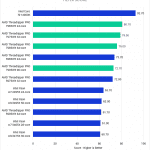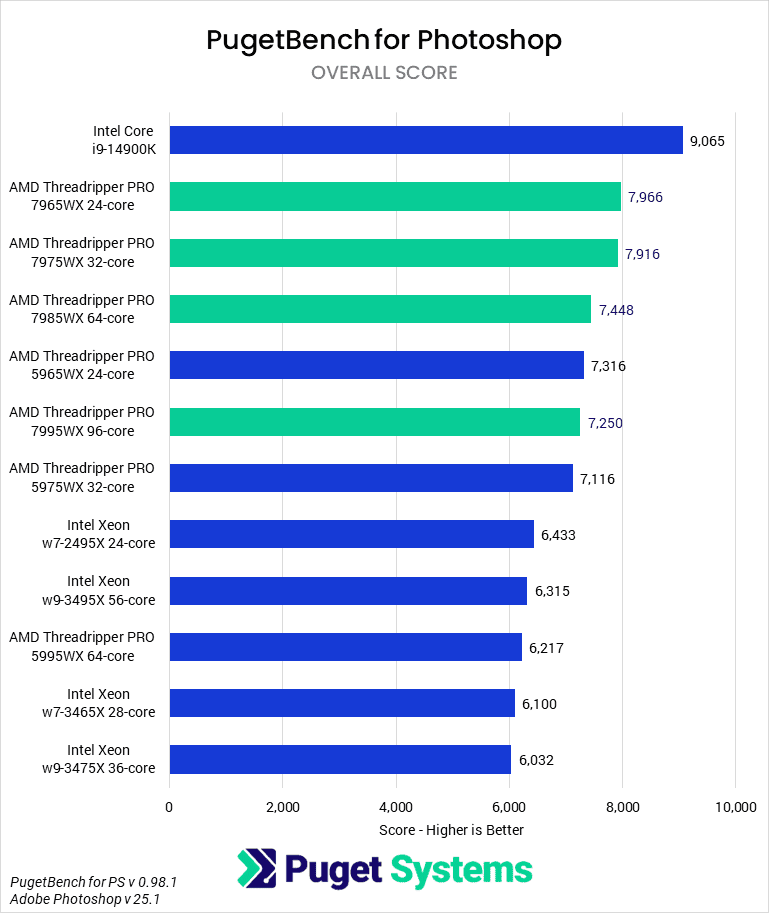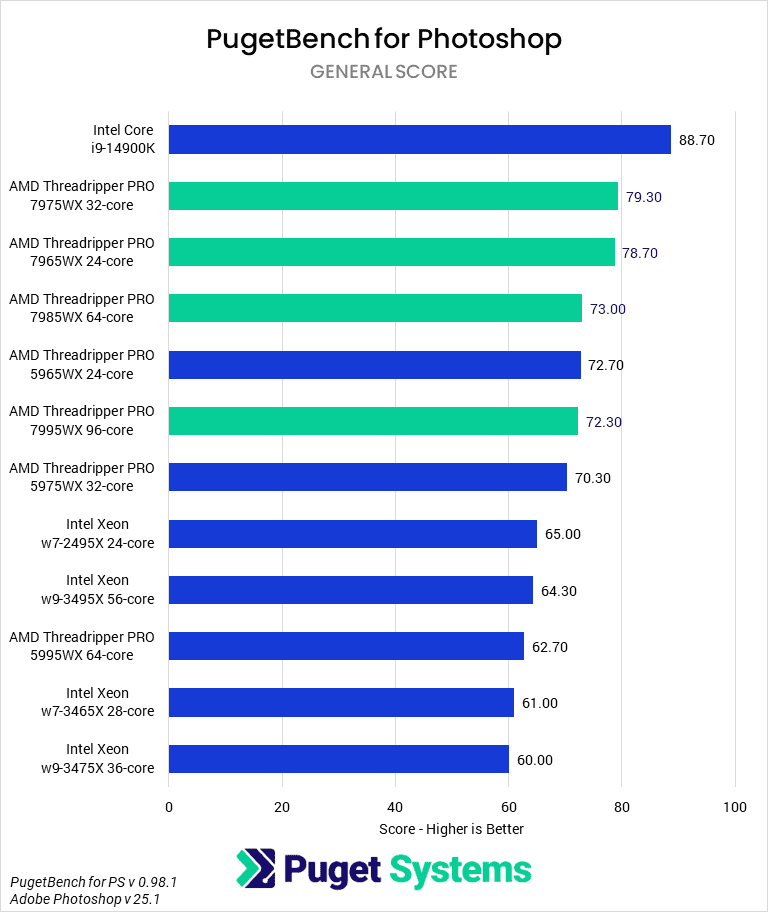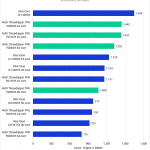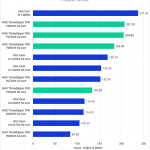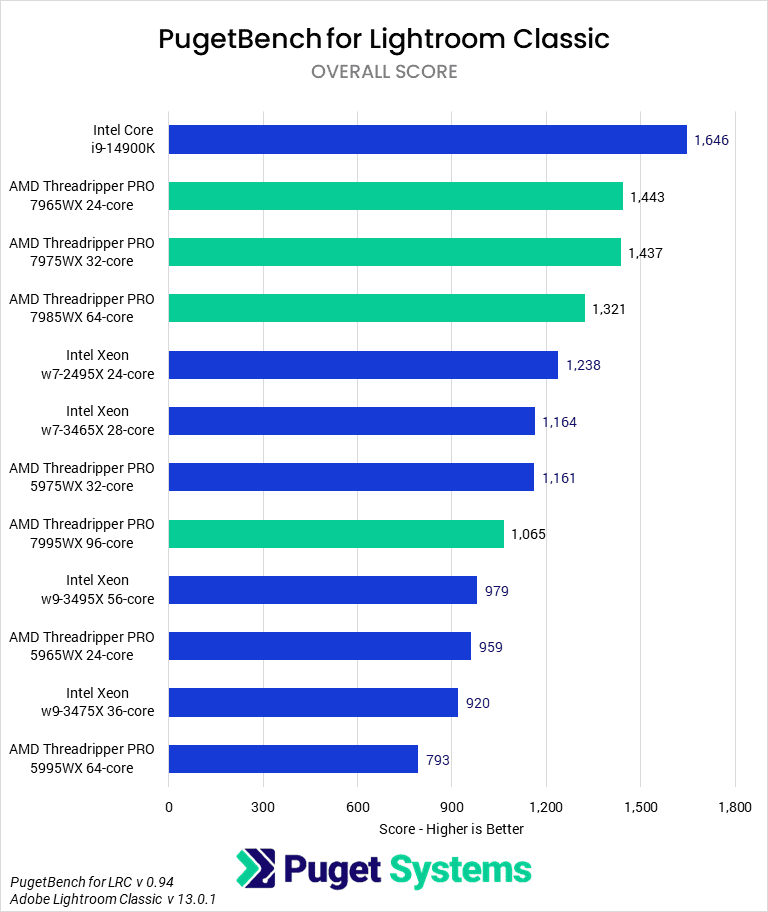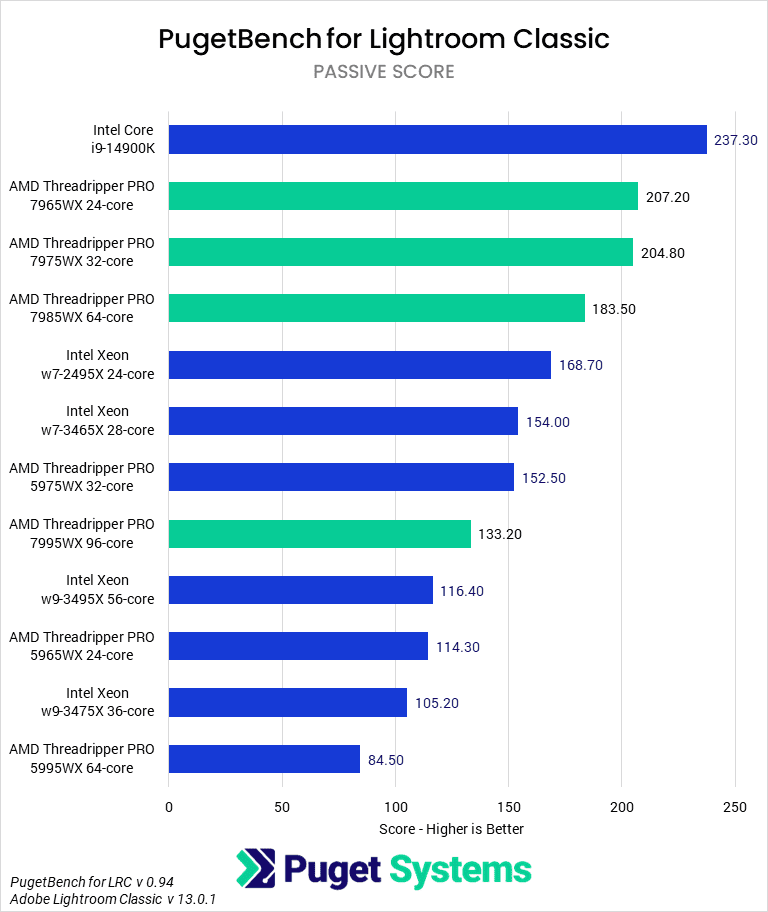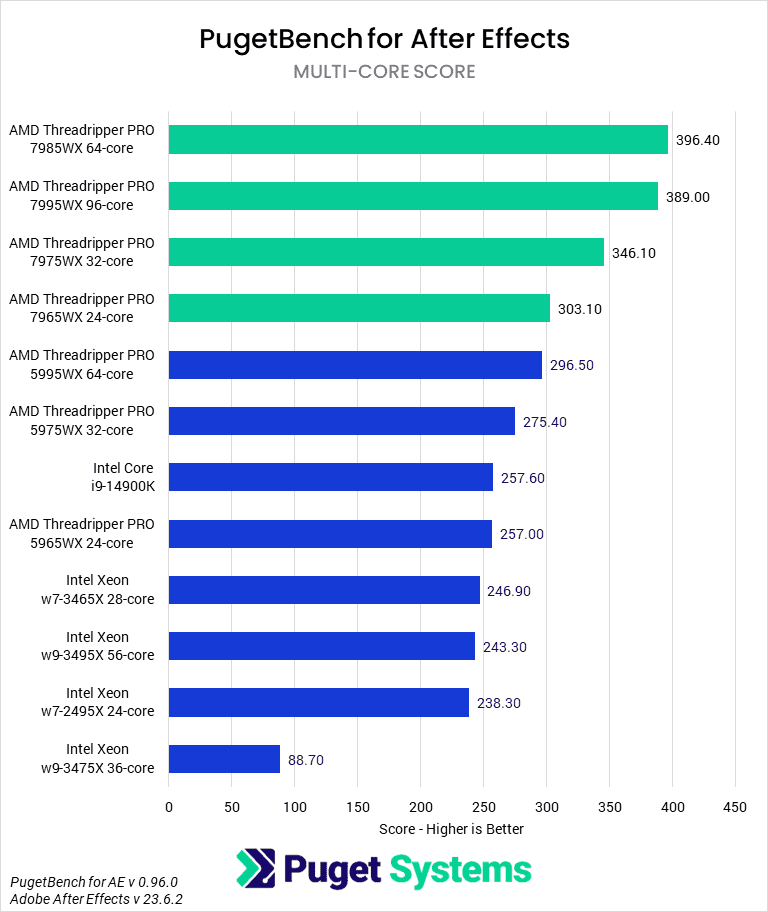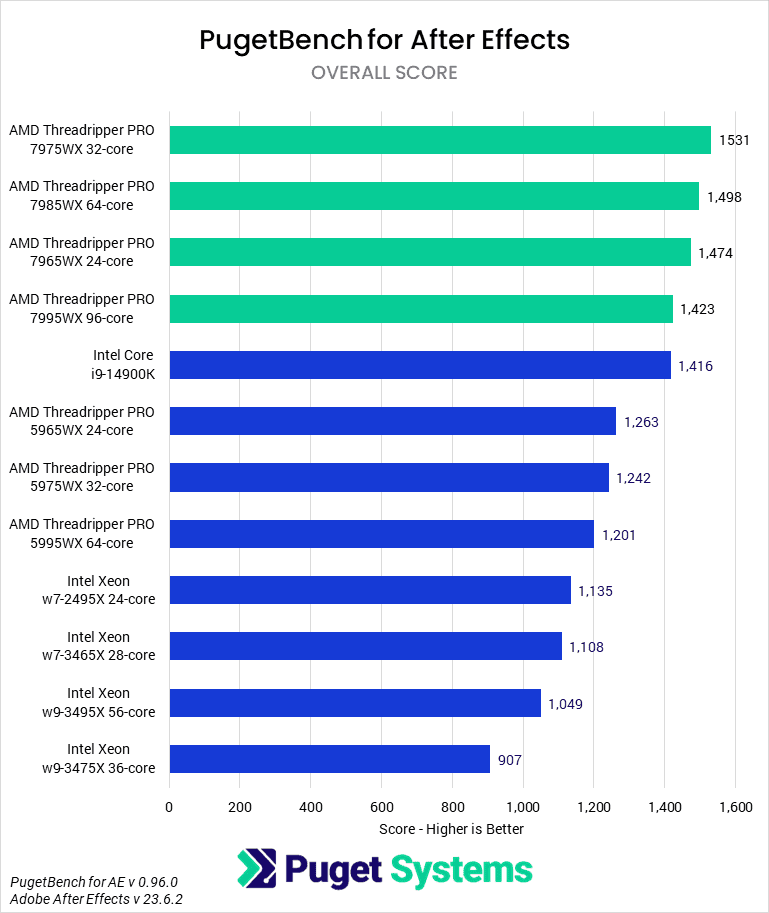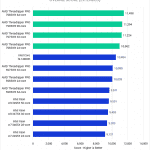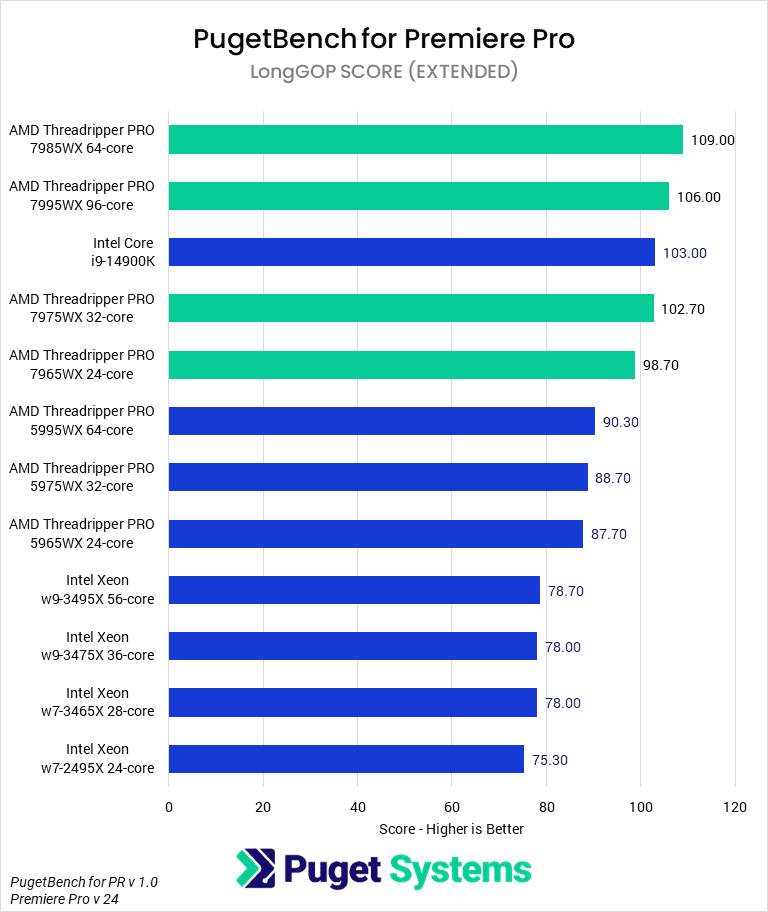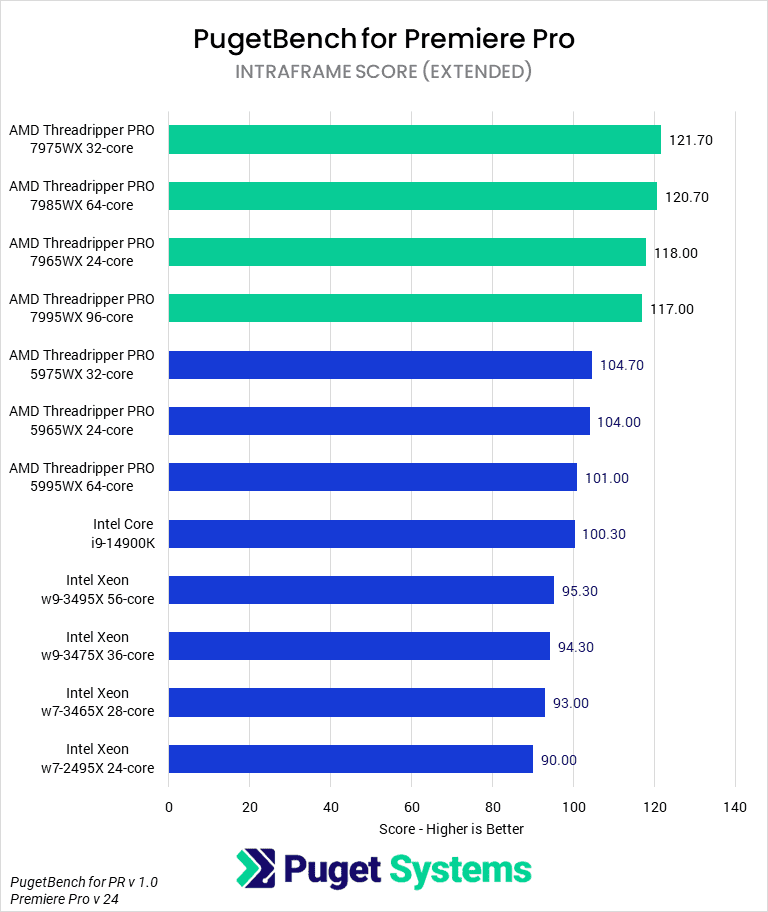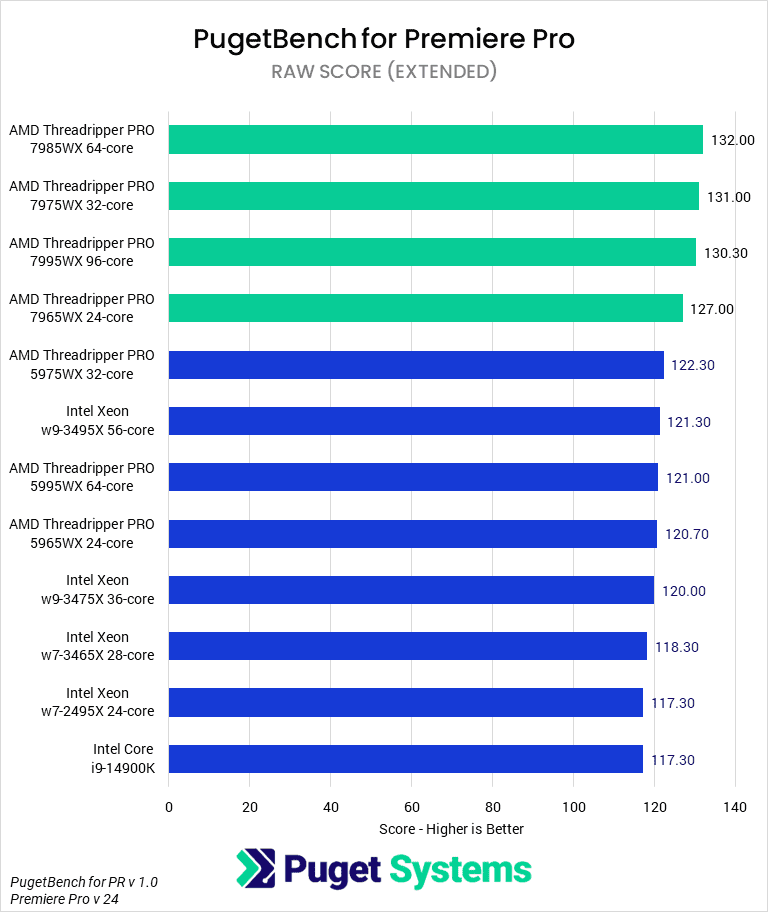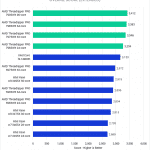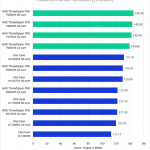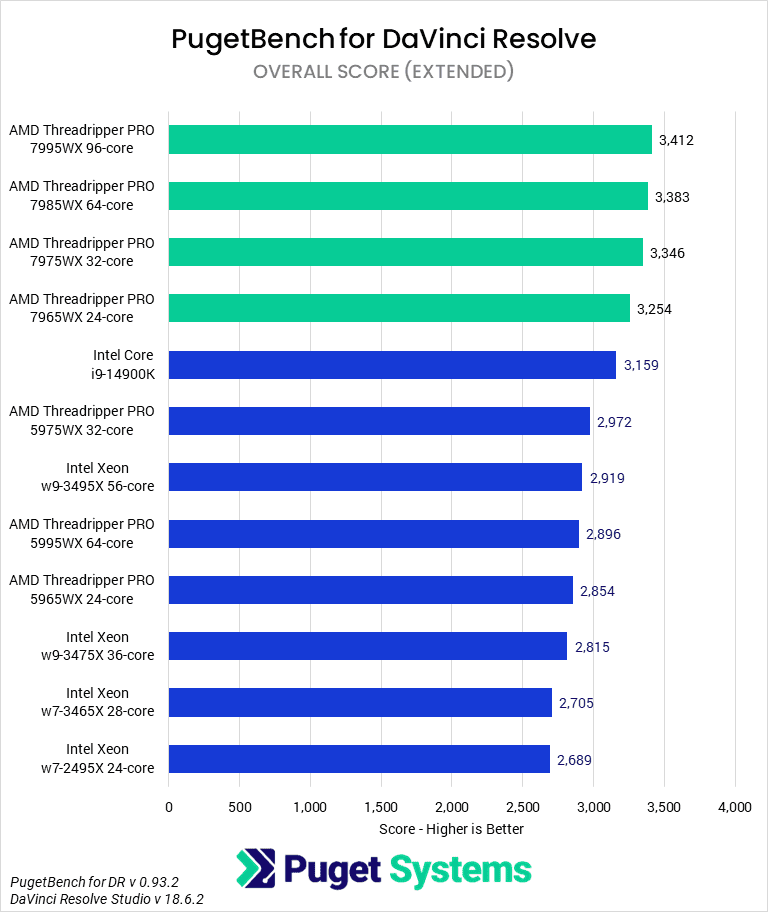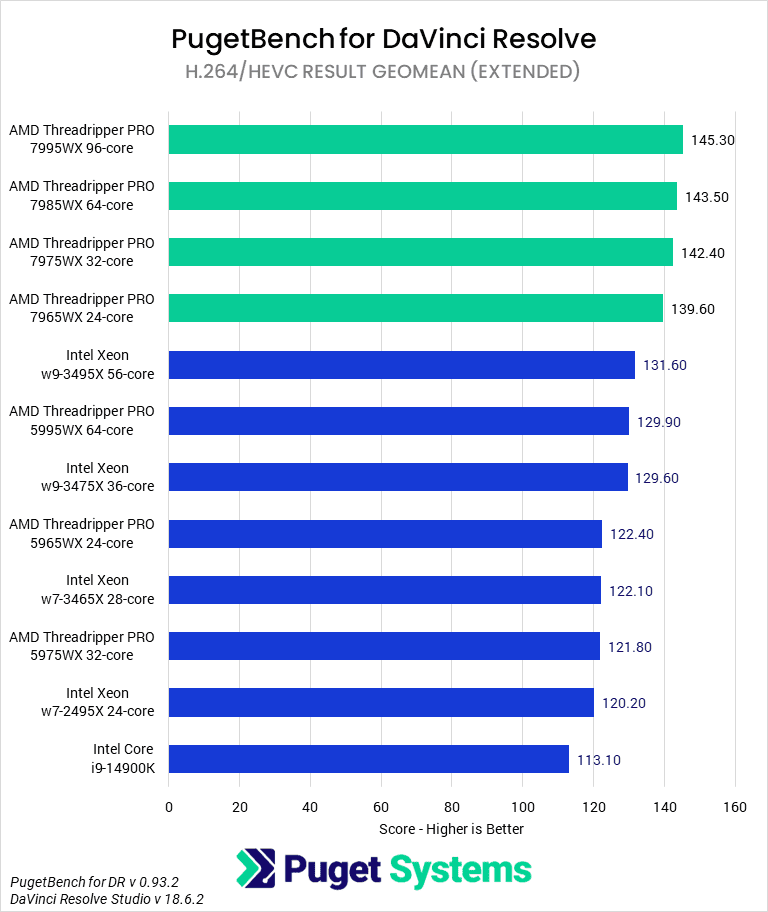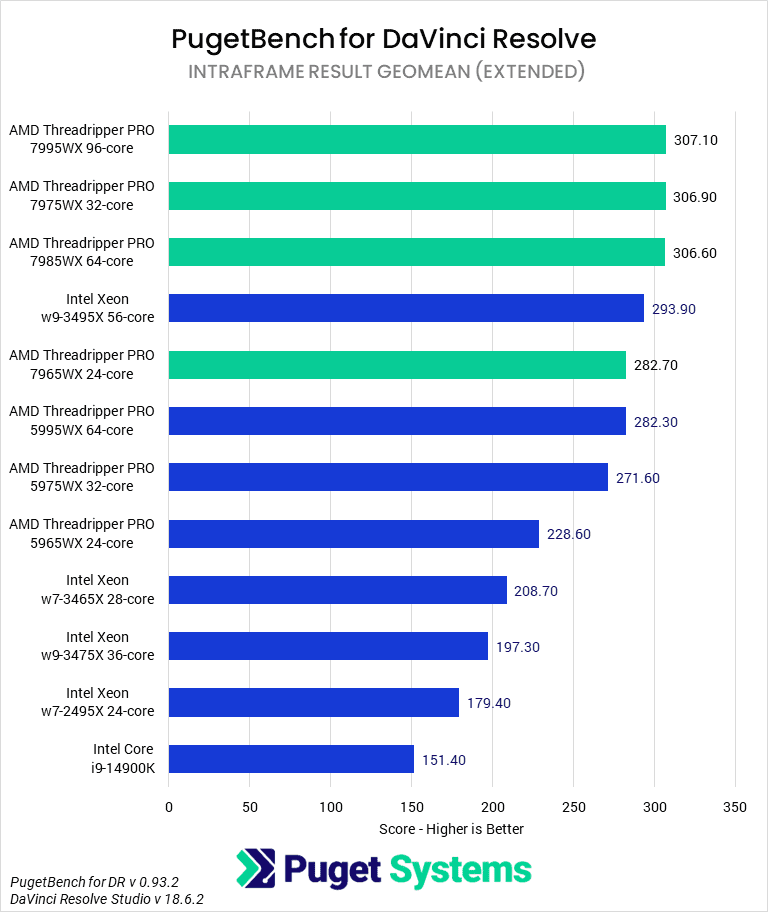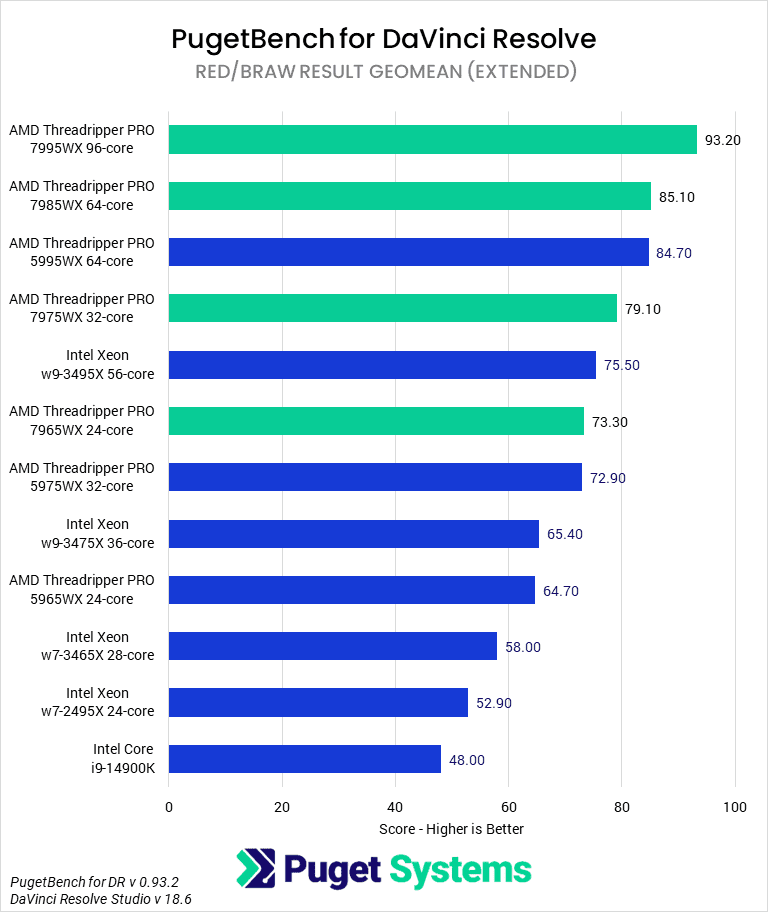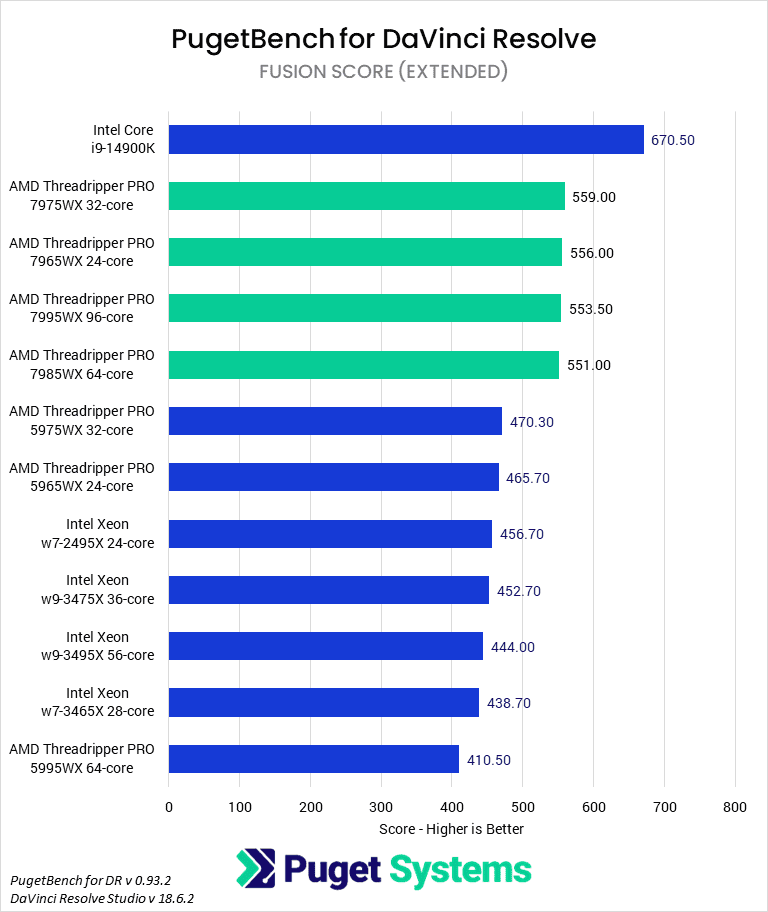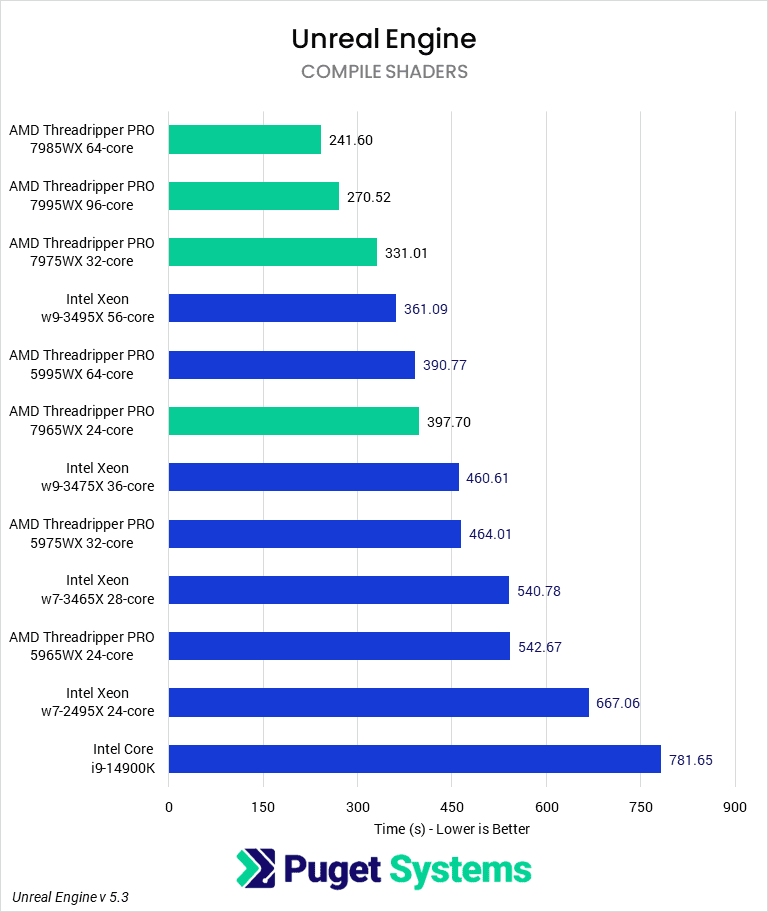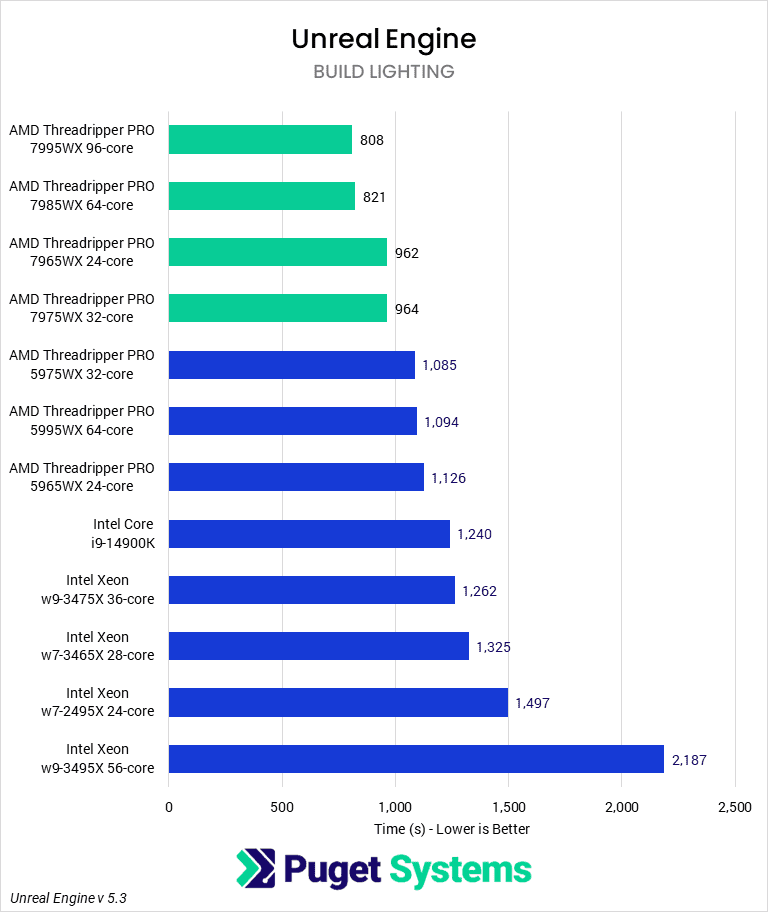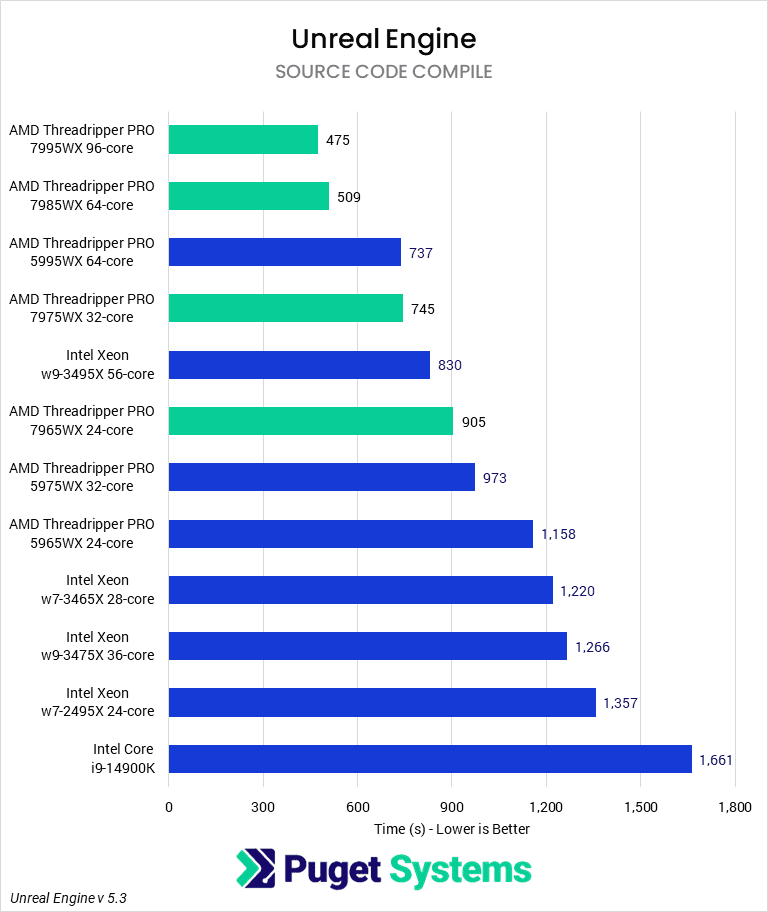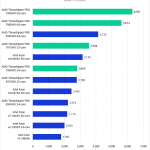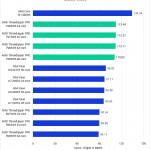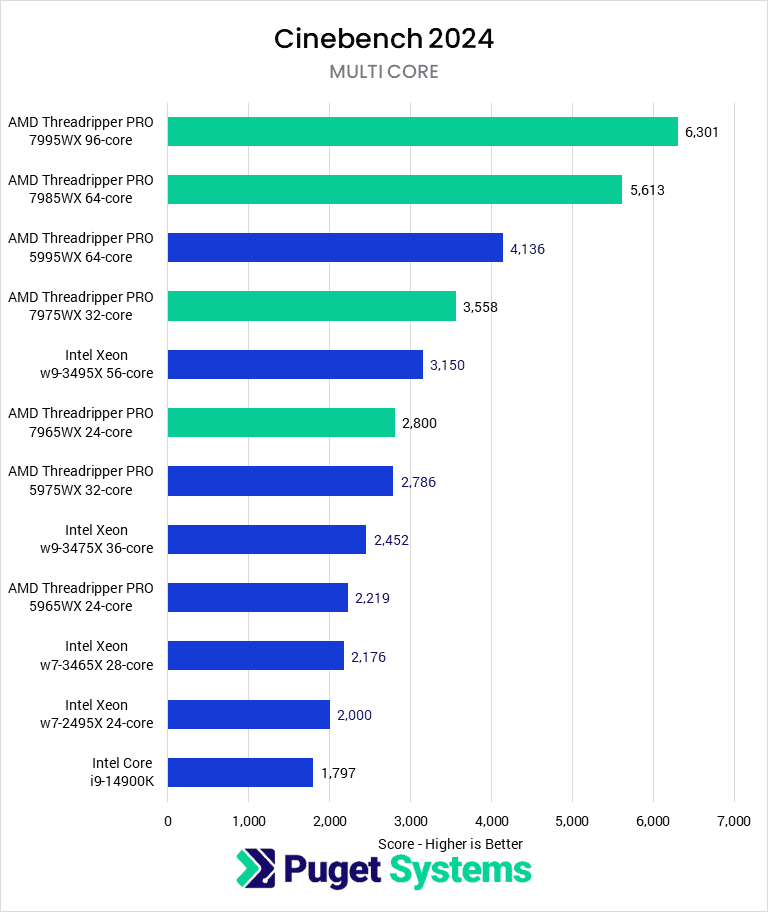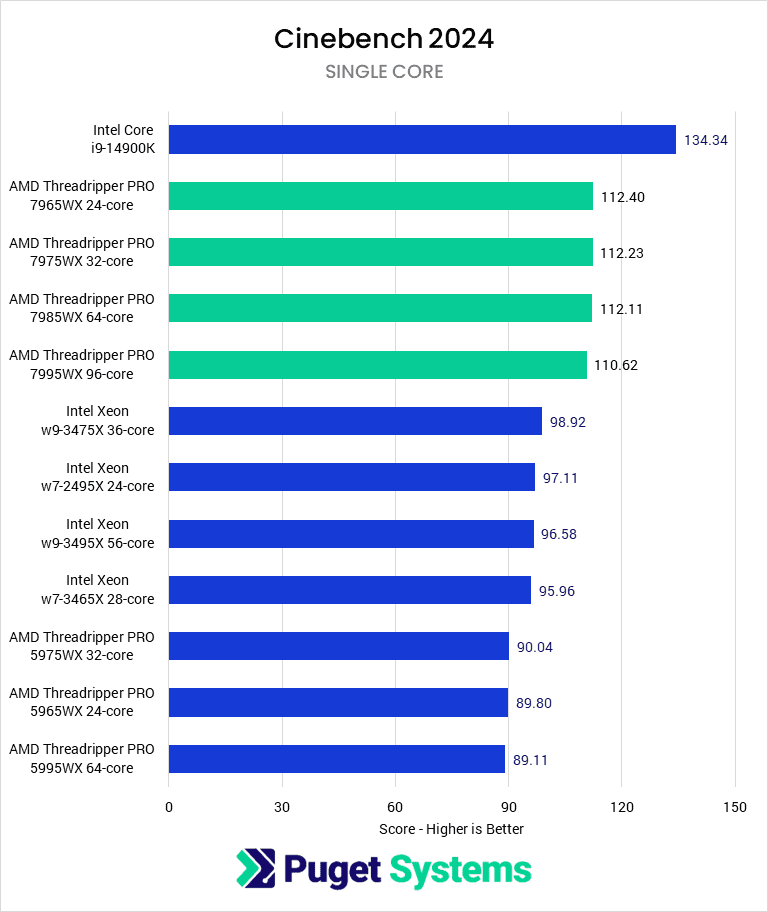Table of Contents
TL;DR: AMD Threadripper PRO 7000WX vs. Intel Xeon W-3400 for Content Creation
Overall, the new AMD Threadripper PRO 7000 WX-Series processors offer a significant performance increase over the previous generation Threadripper PRO 5000 WX-Series, although they do come with a slight price bump which blunts the performance gains slightly. The exact gen-over-gen performance increase varies based on the application but ranges from a moderate ~10% increase in Photoshop and Premiere Pro, to a larger 20–30% in DaVinci Resolve and After Effects, to an incredible 35–45% (or up to 85% higher if you factor in the new 96-core model!) in heavily threaded applications like CPU Rendering.
Across the board, this puts AMD firmly ahead of Intel’s Xeon W-3400 processor family. Exactly by how much varies based on the workload and which models you are comparing, but the Threadripper PRO 7000WX processors range from 25% faster in lightly threaded tasks like Photoshop, to 30-60% in moderately threaded applications like DaVinci Resolve and After Effects. And for heavily threaded workloads like CPU Rendering, the higher core count of Threadripper PRO versus Xeon W-3400 (especially with the new 96-core model), along with their higher per-core performance, can make them anywhere from 70% to more than 2.2x faster!
Introduction
In late 2023, AMD released the latest Ryzen Threadripper 7000 and Ryzen Threadripper PRO 7000 WX-Series processors as a replacement to the previous generation AMD Ryzen Threadripper PRO 5000 WX-Series workstation processors. They offer a large generational improvement over their predecessors, with AMD’s proven Zen 4 architecture supporting DDR5 memory, additional L2 cache, higher clock speeds, and, for the first time, a 96-core variant. Threadripper PRO, in particular, supports 8-channel RAM (allowing for up to 1TB in our workstations) and 128 PCI-e lanes, which positions them well for multi-GPU setups and memory-intensive applications.
The last few generations of Threadripper processors (PRO and otherwise) have boasted the highest multi-core performance in the HEDT and professional workstation space. We found this trend to continue in our AMD Ryzen Threadripper 7000 Content Creation Review, and we expect that the PRO variants of these CPUs will also offer outstanding performance. Their main competitor, Intel’s Xeon W-3400 line, typically falls behind in our content creation benchmarks, although they can have solid benefits in other industries.
Our typical recommended use of AMD Threadripper processors is for applications that are heavily multi-threaded. This includes CPU rendering, code compilation, and parallel rendering like MFR in After Effects. In our AMD Ryzen Threadripper PRO 7995WX Preview (the 96-core variant), we found that we may have to start looking more at multitasking workloads across multiple applications for the very high core-count CPUs due to limited returns in single instances of applications. While we won’t be doing that today, it is something we plan to investigate in the future.
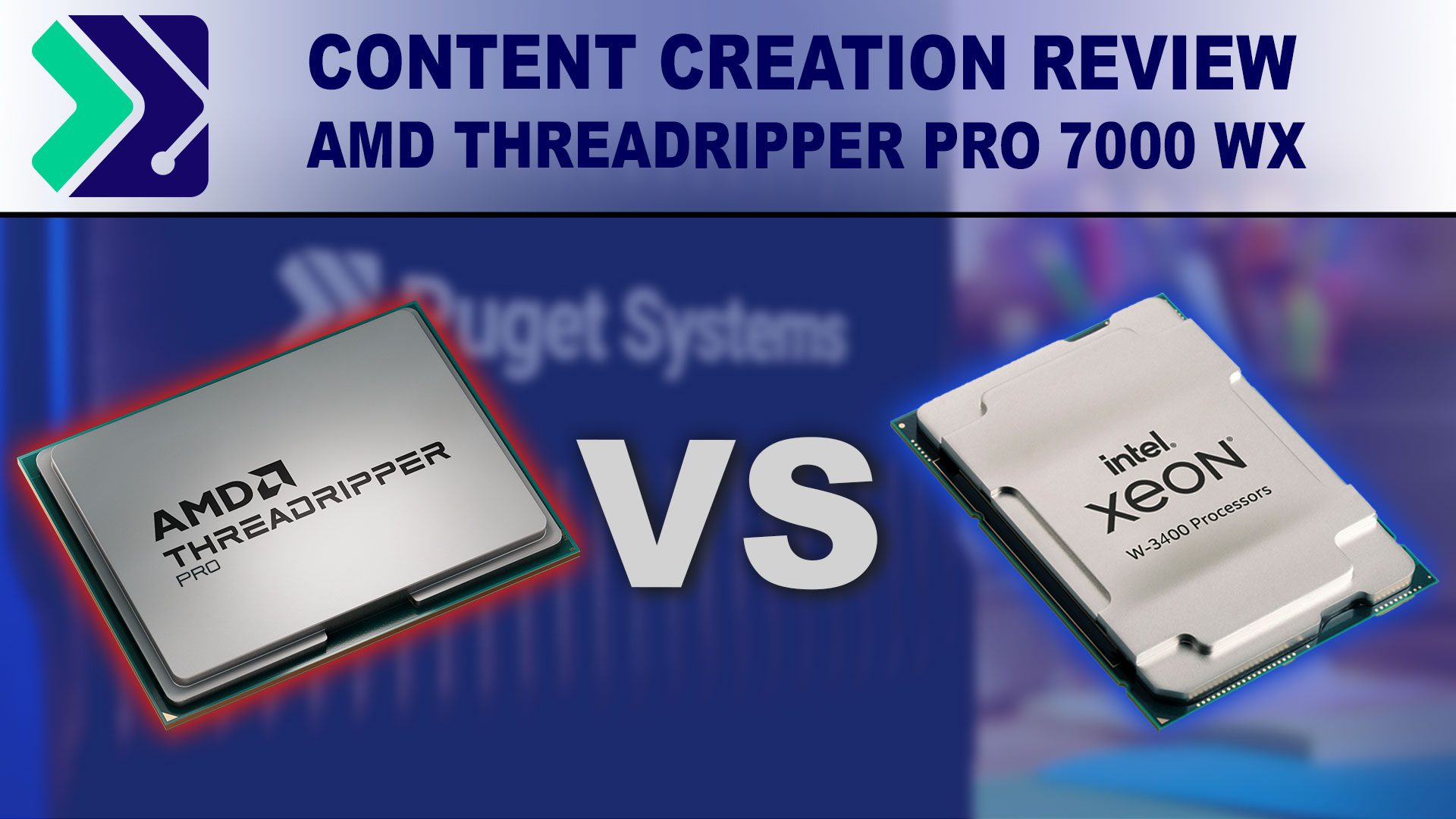
Threadripper PRO 7000WX officially launched several months ago alongside the Threadripper 7000 series, but there was, unfortunately, an industry-wide motherboard shortage that prevented us from doing more than a set of preview testing to gauge how the PRO CPUs may perform. Today, however, we are excited to finally be able to test the new Threadripper PRO 7000 WX-Series of processors. To see a direct comparison between Threadripper 7000X and Threadipper PRO 7000 WX, you can see our AMD Ryzen Threadripper 7000 vs Threadripper PRO 7000WX for Content Creation article.
If you are interested in how the basic specs and pricing of these CPUs compare to the relevant competition from Intel and AMD’s last-gen Threadripper PRO processors, we have that information below. For more information on these processors, you can visit AMD’s Threadripper landing page and the Intel Xeon W Ark pages.
| CPU Model | ~MSRP | Cores | Base / Boost Clock (GHz) | TDP (W) | Memory | L2 / L3 Cache (MB) | Release Date |
|---|---|---|---|---|---|---|---|
| AMD Ryzen Threadripper PRO 7995WX | $10,000 | 96 | 2.5 / 5.1 | 350 | DDR5 5200 Mbps | 96 / 384 | Nov. 21, 2023 |
| AMD Ryzen Threadripper PRO 7985WX | $7,350 | 64 | 3.2 / 5.1 | 350 | DDR5 5200 Mbps | 64 / 256 | Nov. 21, 2023 |
| AMD Ryzen Threadripper PRO 5995WX | $6,500 | 64 | 2.7 / 4.5 | 280 | DDR4 3200 Mbps | 32 / 256 | March 8, 2022 |
| Intel Xeon w9-3495X | $5,900 | 56 | 1.9 / 4.8 | 350 / 420 | DDR5 4800 Mbps | 112 / 105 | Feb. 15, 2023 |
| AMD Ryzen Threadripper PRO 7975WX | $3,900 | 32 | 4.2 / 5.3 | 350 | DDR5 5200 Mbps | 32 / 128 | Nov. 21, 2023 |
| Intel Xeon w9-3475X | $3,740 | 36 | 2.2 / 4.8 | 300 / 360 | DDR5 4800 Mbps | 72 / 82.5 | Feb. 15, 2023 |
| AMD Ryzen Threadripper PRO 5975WX | $3,300 | 32 | 3.6 / 4.5 | 280 | DDR4 3200 Mbps | 16 / 128 | March 8, 2022 |
| Intel Xeon w7-3465X | $2,900 | 28 | 2.5 / 4.8 | 300 / 360 | DDR5 4800 Mbps | 56 / 75 | Feb. 15, 2023 |
| AMD Ryzen Threadripper PRO 7965WX | $2,650 | 24 | 4.2 / 5.3 | 350 | DDR5 5200 Mbps | 24 / 128 | Nov. 21, 2023 |
| AMD Ryzen Threadripper PRO 5965WX | $2,400 | 24 | 3.8 / 4.5 | 280 | DDR4 3200 Mbps | 12 / 128 | March 8, 2022 |
| Intel Xeon w7-2495X | $2,200 | 24 | 2.5 / 4.8 | 225 / 270 | DDR5 4800 Mbps | 48 / 45 | Feb. 15, 2023 |
Unlike in our Threadripper 7000X review, motherboard costs between the various professional workstation platforms (WRX80, WRX90, and W790) are all relatively similar, falling within a couple of hundred dollars of each other; the price ranges overlap depending on the manufacturer. You should generally expect that a motherboard for these CPUs will cost about $1,200. The RAM is similarly expensive as it must be registered ECC.
Price-wise, most of the CPUs tested compare fairly easily, costing around $100 per core with the exception of the 64-core 7985WX, which carries around a $1,000 price premium over the last-generation 64-core 5995WX. Otherwise, the 7000 WX-Series processors carry a small price premium over their last-generation counterparts and are priced closely to the Xeon W-3400 CPUs when accounting for the odd core counts of the Intel processors.
In terms of specifications, the new Threadripper PRO 7000 WX-Series of processors feature a large clock increase over the 5000 WX-Series of 500 MHz. This, alongside IPC improvements from the Zen 4 architecture, should result in a large per-core performance improvement. Compared to the last-gen CPUs, they also feature twice the L2 cache and 70 W higher TDPs—in line with the base power draw of the top-end Xeon W CPUs. Finally, as mentioned earlier, they also support DDR5 ECC Registered memory up to 5200 Mbps.
Test Setup
AMD WRX90 Platform
| CPUs: AMD Ryzen Threadripper PRO 7995WX 96-Core AMD Ryzen Threadripper PRO 7985WX 64-Core AMD Ryzen Threadripper PRO 7975WX 32-Core AMD Ryzen Threadripper PRO 7965WX 24-Core |
| CPU Cooler: Asetek 836S-M1A 360mm |
| Motherboard: Asus Pro WS WRX90E-SAGE SE BIOS version: 0404 |
| RAM: 8x DDR5-5600 16GB (128 GB total) Running at 5200 Mbps |
| Power Profile: Balanced |
Intel W790 Platform
| CPUs: Intel Xeon w9-3495X 56-Core Intel Xeon w9-3475X 36-Core Intel Xeon w7-3465X 28-Core Intel Xeon w7-2495X 24-Core |
| CPU Cooler: Noctua NH-U14S DX-4677 |
| Motherboard: ASUS Pro WS W790E-SAGE SE BIOS version: 0705 |
| RAM: 8x DDR5-4800 16GB (128 GB total) Running at 4800 Mbps |
| Power Profile: High Performance |
AMD WRX80 Platform
| CPUs: AMD Ryzen Threadripper PRO 5995WX 64-Core AMD Ryzen Threadripper PRO 5975WX 32-Core AMD Ryzen Threadripper PRO 5965WX 24-Core |
| CPU Cooler: Noctua NH-U14S TR4-SP3 |
| Motherboard: ASUS Pro WS WRX80E-SAGE SE WIFI BIOS Version: 1201 |
| RAM: 8x DDR4-3200 16GB (128 GB total) Running at 3200 Mbps |
| Power Profile: Balanced |
Universal Platform Components
| GPU: NVIDIA GeForce RTX 4080 16GB Driver Version: Studio 546.01 |
| PSU: Super Flower LEADEX Platinum 1600W |
| Storage: Samsung 980 Pro 2TB |
| OS: Windows 11 Pro 64-bit (22621) |
Benchmark Software
| Lightroom Classic 13.0.1 – PugetBench for Lightroom Classic 0.94 |
| Photoshop 25.1 – PugetBench for Photoshop 0.98.1 |
| Premiere Pro 24.0 – PugetBench for Premiere Pro 1.0 |
| DaVinci Resolve 18.6.2 – PugetBench for DaVinci Resolve 0.93.2 |
| After Effects 23.6 – PugetBench for After Effects 0.96 |
| Unreal Engine 5.3 |
| Cinebench 2024 |
| Blender 3.6.0 |
| V-Ray 5.02.00 |
To keep our testing relatively consistent, we try to standardize a base setup across our testbeds, replicating the configuration on many of our content creation workstations. We review hardware for content creation applications and configure our testing the same way we sell our systems, emphasizing stability and reliability. For example, we don’t clock our memory above the officially supported RAM speeds, and we test with the same CPU coolers we use in our systems.
However, this sometimes means more differences between our test platforms than we would prefer. For example, in this article, the RAM and coolers are not identical across systems. For memory, the WRX80 system only supports DDR4, while the new TRX50 and W790 platforms support DDR5. While this does make it more difficult to tease out what performance gain is due to memory and what is due to the CPU itself, ultimately, what matters is the holistic performance of the system rather than the contribution of any individual component.
The coolers also vary. Due to thermal considerations, we have decided that the TRX50 and WRX90 systems we sell should be configured with an all-in-one liquid cooler (AIO) by default, so we have tested with one here. We did not have compatible AIOs for our WRX80 and W790 systems at the time of testing, so we used our standard Noctua air coolers for those platforms. However, we have done comparisons examining the performance differences with a 64-core CPU between the two types of coolers and found no difference, so the fact that we are not using an AIO for Threadripper 5000WX or Intel Xeon W should not impact our performance comparisons to a significant degree.
Finally, the Intel Xeon W processors were tested with the “High Performance” power plan due to our findings from our initial review, which saw a 20% performance loss from the “Balanced” power plan. We have not observed this being an issue with either the Threadripper PRO 5000 WX-Series or Threadripper PRO 7000 WX-Series, so those were tested with our standard settings: the “Balanced” plan.
On the software side, we are using many of our “PugetBench” benchmarks – some of which were also used by AMD as a part of the official AMD Threadripper 7000 and Threadripper PRO 7000 WX-Series unveiling. We supplement them with several other real-world benchmarks – primarily for rendering packages like Blender and V-Ray. Some of our benchmarks are a bit out of date from our current release, but we maintained versions across this and our prior Threadripper 7000 review so we could properly compare the two.
Graphic Design: Adobe Photoshop
Since most tasks in Photoshop are lightly threaded, performance is largely based on the per-core performance of your CPU. Because of this, you tend not to see much difference between CPUs of the same family, and consumer CPU lines like Intel Core or AMD Ryzen (represented by the Intel Core i9 14900K result in the charts above) are often faster than processor families like Threadripper PRO and Xeon. In addition, lower core count processors can be a bit faster than the ones with more cores, especially above 32 cores, resulting in progressively lower performance as you increase the core count.
This means that CPUs like Intel Core and AMD Ryzen are simply a better fit for Photoshop alone, giving you more performance at a significantly lower cost. Still, given how many workflows utilize Photoshop to some degree, there are many use cases where a user may opt to take a performance hit in Photoshop in order to get better performance in other aspects of their workflow. For example, this is very common in the VFX industry, where rendering or simulation benefits from high CPU core counts, and the work being done in Photoshop is relatively light, so a 10-15% performance hit is acceptable.
With that in mind, AMD has a firm lead in Photoshop with the new Threadripper PRO 7000 WX-Series compared to Intel Xeon W-3400, although the exact amount is tough to quantify since it depends on whether or not you include particularly poor results from CPUs like the Intel Xeon w9-3475X 36-core. Because Photoshop doesn’t scale well with higher core counts, the clearest comparison is with the 24-core models, where the Threadripper PRO 7965WX is about 25% faster than the Intel Xeon w7-2495X.
Compared to the previous generation AMD Threadripper PRO 5000 WX-Series, the new 7000WX processors are around 10% faster. This isn’t much, but one of the good things this time around is that the performance penalty as you cross the 32-core mark is much reduced with the new 7000WX models. Where the 64-core 5995WX was nearly 20% slower than the 32-core 5975WX, the 64-core 7985WX is only 10% slower than the 32-core 7975WX. That still isn’t great, but unless Adobe does something about this issue, there is only so much AMD is likely able to do on the hardware side.
Full performance analysis: Adobe Photoshop: AMD Threadripper PRO 7000 WX-Series vs Intel Xeon W-3400
Photography: Adobe Lightroom Classic
Unlike applications like Photoshop, which are fairly linear in the way they use hardware, Lightroom Classic behaves very differently depending on the type of task you are looking at. Our benchmark breaks down the tests into two groups: active and passive. Active tests (chart #2) look at things like switching modules and scrolling through images that individually take a short amount of time but are done hundreds or thousands of times a day. These tasks are typically lightly threaded, and performance is largely based on the per-core performance of your CPU. On the other hand, passive tasks (chart #3) like importing, exporting, and generating previews are moderately threaded and – up to a certain point – can utilize CPUs with more cores. However, in most cases, even what is available from an Intel Core or AMD Ryzen CPU is enough to “saturate” Lightroom Classic, so once again, Threadripper PRO and Xeon tend to underperform compared to more affordable CPU families.
In addition, Lightroom Classic has an issue where it shows significant performance degradation when you have more than 32 cores (or, more accurately, 64 threads) due to how Windows divides a processor into multiple logical processor groups above that point. Unless an application is programmed to consider these groups, it can result in a heavy performance penalty for very high-core count CPUs (as seen by the 64- and 96-core results being worse than the 24/32 core models)
This means that CPUs like Intel Core and AMD Ryzen are simply a better fit for Lightroom Classic, giving you more performance at a significantly lower cost. Still, some use cases exist where a user may opt to take a performance hit in Lightroom Classic to get better performance in other aspects of their workflow (such as a combination of photography and photogrammetry).
When it comes to comparing AMD Threadripper PRO and Intel Xeon, it is a bit tough to do because, in both cases, the lowest core count model (Threadripper PRO 7965WX 24-core and Intel Xeon w7-2495X 24-core) are the fastest performing model from each family. AMD takes the lead between these two processors with 17% higher performance overall, or 23% for passive tasks in particular.
Going above that level is a bit awkward since different models start to have odd performance results. Case in point is the Xeon w7-3475X 36-core, which we would compare against the TR PRO 7975WX 32-core from a price perspective, except that the w7-3475X gives absolutely terrible results that would make it a CPU that no one would ever choose for Lightroom Classic.
If you throw out the particularly poor results from Intel and AMD, we are looking at somewhere around a 17-60% performance lead for AMD Threadripper PRO 7000 WX-Series over Intel Xeon W-2400/3400 processors depending on which model you are interested in.
Full performance analysis: Adobe Lightroom Classic: AMD Threadripper PRO 7000 WX-Series vs Intel Xeon W-3400
Motion Graphics: Adobe After Effects
Once we get outside of photography and graphic design workloads, we finally start to get a hint of what these new CPUs are capable of in workflows that can benefit from this class of CPU. Within After Effects, there are several different aspects and workflows that dictate how it uses the hardware in your system. In most cases, it is CPU-bound but ranges from being lightly threaded where a CPU with high per-core performance is best, and moderately threaded where a CPU with a high number of cores can provide a performance boost. In addition, the exact project you are working on can have an impact on how well After Effects can utilize the hardware in your system.
Our After Effects benchmark breaks up these workloads into various scores to give you an idea of how a CPU might perform for you. For most people, the Overall Score (chart #2) will be the best single number to look at, as it covers a wide range of projects. However, if you are considering Threadripper PRO, you are most likely dealing with large, complex projects that would justify that investment over a more typical CPU choice like Intel Core or AMD Ryzen. Because of this, we are going to largely focus on the “Multi-Core Score”, which represents the performance for especially large and complex projects where the multi-frame rendering (MFR) feature comes more into play.
Right away, you can tell that AMD fares very well, with Threadripper PRO commanding the entire top half of the Multi-Core Score chart. Starting at the lowest core count, the Threadripper PRO 7965WX 24-core is a bit more expensive than the Intel Xeon w7-2495X 24-core, but scores an impressive 27% higher for heavy projects in After Effects. A step up from that, the 7975WX 32-core is about 40% faster than the Xeon w7-2465X 28-core (we skipped over the w9-3475X since it gives very poor results in After Effects).
At the upper end of the product stack, the Threadripper PRO 7985WX 64-core and 7995WX 96-core perform about the same, which means that the only reason to invest in the 7995WX is if your workflow includes heavy amounts of multitasking. For price, both are well above any Intel Xeon W-3400 processor, with the closest comparison being the Xeon w9-3495X 56-core at $5,900. That is still a $1,450 premium for the 7985WX 64-core ($7,350 vs $5,900) and a $4,000 premium for the 7995WX 96-core ($10,000 vs $5,900). In terms of performance, these two CPUs come in at about 63% faster than the Intel Xeon w9-3495X, which, especially for the 64-core model, could easily be worth the investment depending on your workflow.
Full performance analysis: Adobe After Effects: AMD Threadripper PRO 7000 WX-Series vs Intel Xeon W-3400
Video Editing: Adobe Premiere Pro
Video Editing applications like Premiere Pro are some of the most complex workflows we look at for CPU performance, as the best CPU depends on the type of media you are working with. LongGOP codecs like H.264 and HEVC (chart #2) are among the most commonly used and are a bit unique in that the hardware decoding and encoding capabilities of your system are often more important than the raw power of your CPU. On the other hand, Intraframe codecs (chart #3) like ProRes and DNxHR are purely CPU-based, while RAW codecs (chart #4) like RED, ARRIRAW, and X-OCN are a mixed bag in how they use your system but often benefit from having a combination of both a powerful CPU and a powerful GPU.
Right away, you can tell that the new AMD Threadripper PRO 7000WX line does very well, with even the 7965WX 24-core scoring above the fastest Intel Xeon W processor. We do want to point out that the Intel Core i9-14900K is only a few percent behind, largely due to its terrific performance for H.264 and HEVC codecs, but for heavier (or CPU-bound) codecs like RED and Sony X-OCN, the 14900K doesn’t keep up as well compared to Threadripper PRO.
Interestingly, Premiere Pro doesn’t scale particularly well with extremely high core counts, and the Threadripper PRO 7995WX 96-core scored only a few percent higher than the 7965WX 24-core. Luckily, having more cores doesn’t seem to hurt performance like we saw in our Photoshop or Lightroom Classic testing, but in most cases, there is little reason to invest in more than the 24-core model unless you want additional headroom for multitasking.
Still, even without much in the way of multi-core scaling, the new Threadripper PRO 7000 WX-Series is around 20% faster than a comparable Intel Xeon W-3400 processor.
Full performance analysis: Adobe Premiere Pro: AMD Threadripper PRO 7000 WX-Series vs Intel Xeon W-3400
Video Editing / Motion Graphics: DaVinci Resolve Studio
DaVinci Resolve Studio is similar to Premiere Pro in that your CPU choice often comes down to what type of media you typically work with. Our results are broken apart in the same way, looking at LongGOP (chart #2), IntraFrame (chart #3), and RAW codecs (charts #4). However, DaVinci Resolve is unique in that it includes Fusion (chart #5), used for motion graphics and VFX. Unlike the rest of Resolve, Fusion is primarily single-threaded, which typically makes an Intel Core or AMD Ryzen CPU better in terms of raw performance than Threadripper or Xeon (by about 20% in this case).
With that explained, we can look at how the new AMD Threadripper PRO 7000 WX-Series compares to the Intel Xeon W-3400 line. As you can likely tell from the fact that the new Threadripper PRO processors take all four of the top spots in our chart, these new CPUs do very well. Even the 7965WX 24-core manages to solidly beat the fastest Intel Xeon W-3400 processor to the tune of about 10%. That isn’t a massive difference, but AMD’s lead grows if you focus on specific workflows that really benefit from this type of CPU, such as processing RAW media like RED and BlackMagic RAW.
For that type of workflow, AMD takes between a 13% and 40% performance lead, depending on which model you look at. The performance difference is larger at the lower core counts, with the 7965WX 24-core beating the Intel Xeon w7-2495X 24-core by a massive 40%. The 7975WX 32-core, on the other hand, is only 21% faster than the Xeon w9-3475X 36-core, and the 7985WX 64-core is 13% faster than the Xeon w9-3495X 56-core. AMD’s lead increases a bit to 23% with the 7995WX 96-core, although at $10,000, that processor is significantly more expensive than anything in Intel’s Xeon W-3400 line.
Overall, like many other applications, the exact benefit of AMD Threadripper PRO 7000WX over Intel Xeon W-3400 will depend on what you are doing. On average, AMD has a relatively modest 10% performance advantage over Intel, but that can grow all the way up to around 40% depending on what type of codec you tend to work with and the exact processor model you are interested in.
Full performance analysis: DaVinci Resolve: AMD Threadripper PRO 7000 WX-Series vs Intel Xeon W-3400
Game Dev / Virtual Production: Unreal Engine
Unreal Engine has a very wide variety of users in different industries, and most of the heavy lifting in Unreal Engine is GPU-bound. Regarding CPU-specific tasks, we look at shader compilation (which everyone experiences from time to time at the very least), light baking, and code compilation in Visual Studio. Light baking is quickly falling out of favor with the adoption of Lumen and GPU Lightmass, but some users may still prefer it. Unreal Engine also has some workflows that can take advantage of the extra memory channels offered by the WRX90 chipset that are not available on the non-pro CPUs.
Starting with the top of the new 96-core Threadripper PRO model, the 7995WX, we see some mixed results. In the shader compile test, this CPU failed to utilize all 96 cores properly – likely due to an issue with how Windows uses processor groups. This isn’t the first time we’ve seen issues with CPUs with more than 32 cores/64 threads while doing Unreal testing, but there is a good chance this will be fixed with a future BIOS or Windows update. In our initial review of the non-pro 64-core 7980X, we saw it not being fully utilized, but, after some updates, it is now performing as expected. Turning to Light baking, the 96-core again falls behind the 64-core, but by a smaller margin. With source code compiling, we see the 7995WX take a small lead over the rest of the pack. Whether the extra cost is worth saving 30 seconds on the time to compile is worth is will be a tough question to answer for many users.
Thankfully, the issues we initially experienced with the 64-core Threadripper 7980X appear to have been fixed, and the Threadripper PRO 7985WX 64-core performs as expected. In shader compiling, the 64-core holds an impressive 33% lead over the 56-core Intel Xeon w9-3495X and is nearly 40% faster in compiling the source code in Visual Studio. This new CPU also placed at the top of the chart for building lighting, but it is not a fair comparison to the 56-core Xeon as it had processor scheduling issues and posted the slowest time of all CPUs tested.
The 32-core Threadripper PRO 7975WX is price comparable to the Xeon w9-3475X, though the Xeon has 4 more cores. Not only did the Threadripper PRO outperform the similarly priced Xeon by a wide margin, but it is even faster than the top-of-the-line 56-core w9-3495X. This gives the 7975WX a great performance for the value. In the shader compile test, the 32-core 7975WX takes 5 minutes and 30 seconds, while the 64-core 7985WX completes it in 4 minutes flat. Many users may not encounter compile times this long in the real world or face them that often. For these users, the extra $3500 may be better served elsewhere.
Moving down to the 24-core Threadripper 7965WX, it routinely outperformed the 24-core Xeon w7-2495, though it is roughly 20% more expensive. On average, it is around 40% faster, so that extra cost does give even greater performance.
Full performance analysis: Unreal Engine: AMD Threadripper PRO 7000 WX-Series vs Intel Xeon W-3400
CPU Rendering: Cinebench 2024
CPU-based rendering highly favors CPUs with high core counts. Xeon, Threadripper, and Epyc are the go-to choices for any render farm or those building a workstation. However, there is more to consider than just the number of cores. Clock speed, IPC, and RAM speeds all play a part in how well a CPU performs in this task. While most C4D and Redshift users default to GPU for rendering due to its much faster performance, some still rely on CPU due to the limited memory available on video cards, or if they don’t have an active Redshift licence. Despite the incredible rendering speeds of GPUs, if your project can’t fit into the VRAM then you’ll still need to render on the CPU.
Starting with the Threadripper PRO 7995WX 96-core, there just isn’t any comparison as it scores double that of the top Intel CPU. Keep in mind that it is nearly double the cost as well. The more interesting comparison is with the 64-core Threadripper Pro 7985WX. While the 7995WX has 50% more cores, it is only 12% faster. Scaling with more cores is never linear, but this is much lower than we saw in the other rendering packages we will get to in a moment. This may be a limitation of this new version of Cinebench 2024 and its move to Redshift.
The 64-core 7985WX is a closer match-up to the Intel 56-core w9-3495X, and here, AMD scores 78% higher. While it is also more expensive, roughly 25% more, that extra cost brings even more performance for the money.
The 32-core Threadripper 7975WX is price comparable to the Xeon w9-3475X, though the Xeon has 4 more cores. Not only did the Threadripper outperform the similarly priced Xeon by 45%, but it even beat the top-of-the-line 56-core w9-3495X.
Moving down to the 24-core Threadripper 7965WX, it routinely outperformed the 24-core Xeon w7-2495, though it is roughly 20% more expensive. On average, it is around 40% faster, so that extra cost does give even greater performance.
Full performance analysis: Cinema 4D: AMD Threadripper PRO 7000 WX-Series vs Intel Xeon W-3400
CPU Rendering: V-Ray
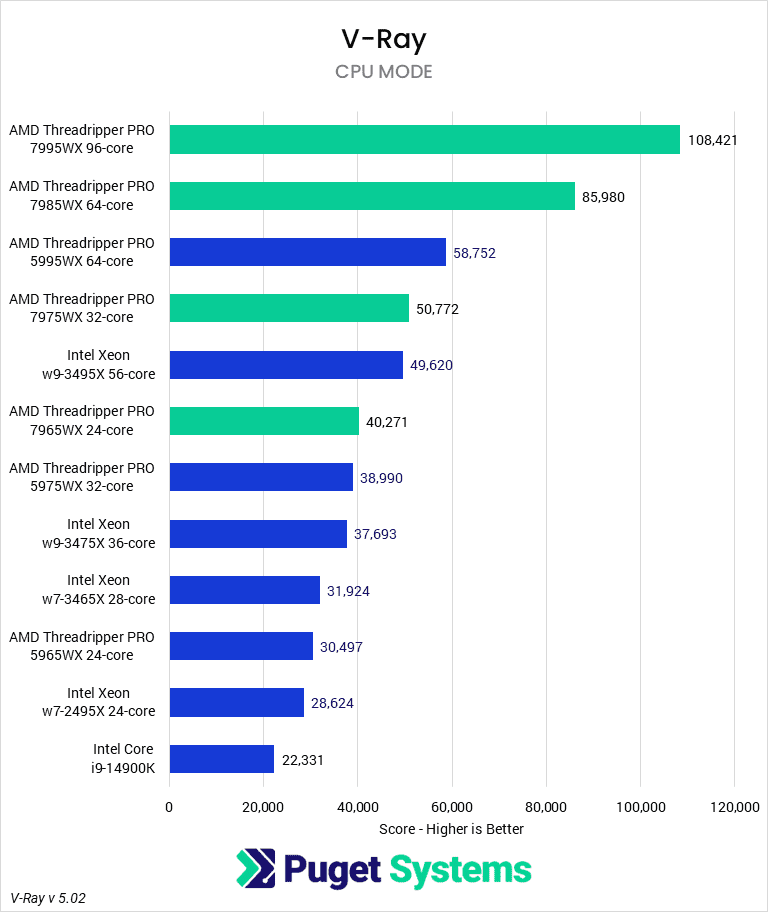
In V-Ray, we see much of the same results as Cinebench 2024, only the 96-Core 7995WX does much better this time, coming in at 26% faster than the 7985WX. The 64-core 7985WX is roughly 73% faster than the Intel 56-core w9-3495X, though it is also 25% more expensive.
With the 32-core Threadripper 7975WX compared to the Intel Xeon w9-3475X, AMD again comes out on top to the tune of 35%, but it also ties with the more expensive 56-core w9-3495X. Moving down to the 24-core Threadripper 7965WX, it routinely outperformed the 24-core Xeon w7-2495, though it is roughly 20% more expensive. It is around 32% faster on average, so that extra cost gives even greater performance.
Full performance analysis: V-Ray: AMD Threadripper PRO 7000WX vs Intel Xeon W-3400
CPU Rendering: Blender
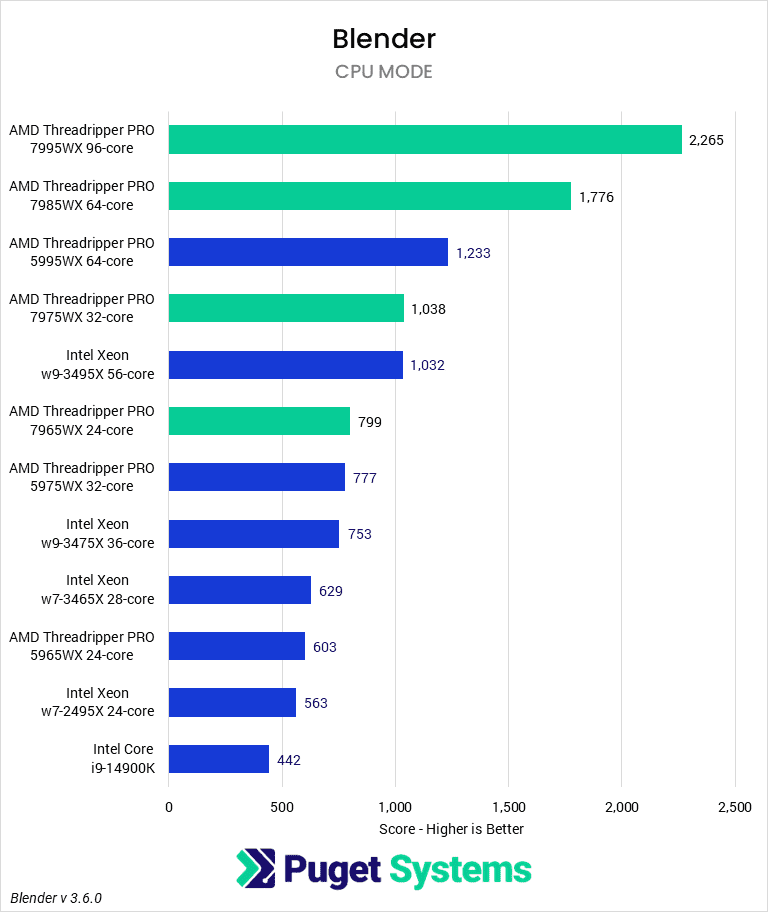
Blender results are nearly identical to V-Ray. The 96-Core 7995WX again does much better than Cinema4D, coming in at 26% faster than the 7985WX. The 64-core 7985WX is roughly 73% faster than the Intel 56-core w9-3495X, though it is also 25% more expensive.
The 32-core Threadripper 7975WX is 35% faster than the Xeon w9-3475X, and once again tied the top-of-the-line 56-core w9-3495X. Moving down to the 24-core Threadripper 7965WX, it scored 32% higher than the Intel Xeon w7-2495
Full performance analysis: Blender: AMD Threadripper PRO 7000WX vs Intel Xeon W-3400
How good are the AMD Ryzen Threadripper PRO 7000 WX-Series of processors for content creation?
Overall, the new AMD Threadripper PRO 7000 WX-Series processors offer a significant performance increase over the previous generation Threadripper PRO 5000 WX-Series, although they do come with a slight price bump which blunts the performance gains slightly. The exact gen-over-gen performance increase varies based on the application but ranges from a moderate ~10% increase in Photoshop and Premiere Pro, to a larger 20–30% in DaVinci Resolve and After Effects, to an incredible 35–45% (or up to 85% higher if you factor in the new 96-core model!) in heavily threaded applications like CPU Rendering.
Across the board, this puts AMD firmly ahead of Intel’s Xeon W-3400 processor family. Exactly by how much varies based on the workload and which models you are comparing, but the Threadripper PRO 7000WX processors range from 25% faster in lightly threaded tasks like Photoshop, to 30-60% in moderately threaded applications like DaVinci Resolve and After Effects. And for heavily threaded workloads like CPU Rendering, the higher core count of Threadripper PRO versus Xeon W-3400 (especially with the new 96-core model), along with their higher per-core performance, can make them anywhere from 70% to more than 2.2x faster!
It is worth noting that even though the Threadripper PRO 7000WX processors do very well in these applications, the normal Threadripper 7000 line will, in many cases, perform within a few percent – and at a much lower price. Threadipper 7000 uses 4-channel RAM (vs. 8-channel on the PRO line) and only supports 48 Gen5 PCIe lanes through the CPU (vs. 128 on the PRO line), but those are not significant factors for many of these workloads. If you want a deeper dive around whether the PRO line is worth the investment, we have a dedicated AMD Threadripper 7000 vs AMD Threadripper PRO 7000WX for Content Creation article we recommend checking out.
But, if your workflow does benefit from the features found in Threadripper PRO, it is a fact that the new 7000 WX-Series are the fastest processors we have tested to date. Certainly, they give AMD a firm lead over Intel’s Xeon W family and really only leaves the question of whether Threadripper PRO 7000WX is worth the investment or if using Threadripper 7000 (non-PRO) is the better option so you can allocate more of your budget towards things like more RAM or faster storage.
Finding the perfect workstation doesn’t have to be complicated. Explore our solutions page for a curated selection of recommended systems for a multitude of applications and workflows, or visit our custom configuration page if you already know the ideal hardware for your needs. If you need assistance with tailoring a system to a unique workflow or have any other questions, we encourage you to reach out to our dedicated technology consultants.




